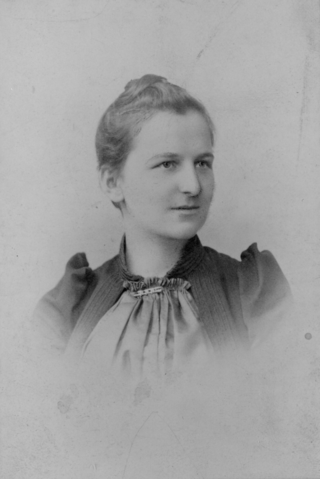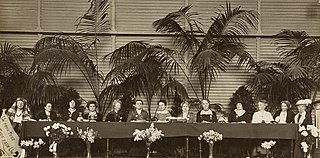
The National American Woman Suffrage Association (NAWSA) was an organization formed on February 18, 1890, to advocate in favor of women's suffrage in the United States. It was created by the merger of two existing organizations, the National Woman Suffrage Association (NWSA) and the American Woman Suffrage Association (AWSA). Its membership, which was about seven thousand at the time it was formed, eventually increased to two million, making it the largest voluntary organization in the nation. It played a pivotal role in the passing of the Nineteenth Amendment to the United States Constitution, which in 1920 guaranteed women's right to vote.

Carrie Chapman Catt was an American women's suffrage leader who campaigned for the Nineteenth Amendment to the United States Constitution, which gave U.S. women the right to vote in 1920. Catt served as president of the National American Woman Suffrage Association from 1900 to 1904 and 1915 to 1920. She founded the League of Women Voters in 1920 and the International Woman Suffrage Alliance in 1904, which was later named International Alliance of Women. She "led an army of voteless women in 1919 to pressure Congress to pass the constitutional amendment giving them the right to vote and convinced state legislatures to ratify it in 1920". She "was one of the best-known women in the United States in the first half of the twentieth century and was on all lists of famous American women."

The International Alliance of Women is an international non-governmental organization that works to promote women's rights and gender equality. It was historically the main international organization that campaigned for women's suffrage. IAW stands for an inclusive, intersectional and progressive liberal feminism on the basis of human rights and liberal democracy, and has a liberal internationalist outlook. IAW's principles state that all genders are "born equally free [and are] equally entitled to the free exercise of their individual rights and liberty," that "women's rights are human rights" and that "human rights are universal, indivisible and interrelated." In 1904 the Alliance adopted gold as its color, the color associated with the women's suffrage movement in the United States since 1867 and the oldest symbol of women's rights; through the Alliance's influence gold and white became the principal colors of the mainstream international women's suffrage movement.

The International Congress of Women was created so that groups of existing women's suffrage movements could come together with other women's groups around the world. It served as a way for women organizations across the nation to establish formal means of communication and to provide more opportunities for women to ask the big questions relating to feminism at the time. The congress has been utilized by a number of feminist and pacifist events since 1878. A few groups that participated in the early conferences were The International Council of Women, The International Alliance of Women and The Women's International League for Peace and Freedom.

The Open Christmas Letter was a public message for peace addressed "To the Women of Germany and Austria", signed by a group of 101 British suffragists at the end of 1914 as the first Christmas of the First World War approached. The Open Christmas Letter was written in acknowledgment of the mounting horror of modern war and as a direct response to letters written to American feminist Carrie Chapman Catt, the president of the International Woman Suffrage Alliance (IWSA), by a small group of German women's rights activists. Published in January 1915 in Jus Suffragii, the journal of the IWSA, the Open Christmas Letter was answered two months later by a group of 155 prominent German and Austrian women who were pacifists. The exchange of letters between women of nations at war helped promote the aims of peace, and helped prevent the fracturing of the unity which lay in the common goal they shared, suffrage for women.

Lucretia Mott was an American Quaker, abolitionist, women's rights activist, and social reformer. She had formed the idea of reforming the position of women in society when she was amongst the women excluded from the World Anti-Slavery Convention held in London in 1840. In 1848, she was invited by Jane Hunt to a meeting that led to the first public gathering about women's rights, the Seneca Falls Convention, during which the Declaration of Sentiments was written.

Rudolph Blankenburg was an American businessman and manufacturer, who became a politician and elected mayor of Philadelphia, leading a reform administration from 1911 to 1916.

Käthe Schirmacher was a German writer, journalist, and political activist who was considered to be one of the leading advocates for women's rights and the international women's movement in the 1890s.

Annie Fredrika Furuhjelm was a Finnish journalist, feminist activist, and writer. She was a member of the Parliament of Finland from 1913 to 1924 and again from 1927 to 1929, representing the Swedish People's Party of Finland (SFP). She was the first enfranchised woman in Europe to serve as a delegate to the International Women Suffrage Alliance and the first elected female legislator to speak before the British Parliament.

Women at the Hague was an International Congress of Women conference held at The Hague, Netherlands in April 1915. It had over 1,100 delegates and it established an International Committee of Women for Permanent Peace (ICWPP) with Jane Addams as president. It led to the creation of the Women's International League for Peace and Freedom (WILPF).
First Conference of the International Woman Suffrage Alliance was held in 1902 in Washington D.C. to consider the feasibility of organizing an International Woman Suffrage Association.
Fourth Conference of the International Woman Suffrage Alliance was held from 15 - 21 June 1908, at the Concertgebouw, Amsterdam, Netherlands.

The Fifth Conference of the International Woman Suffrage Alliance was held in London, England from April 26 to May 1, 1909. Twenty countries were represented. Representatives from twenty countries attended, with Carrie Chapman Catt presiding. Delegates included Johanna Munter (Denmark), Rosika Schwimmer (Hungary), Dr. Anita Augspurg (Germany), Zinaida Mirovitch (Russia), and Gina Krog (Norway).

Sixth Conference of the International Woman Suffrage Alliance was held in June 1911 in Stockholm, Sweden. It was led by the organization's president, Carrie Chapman Catt.

The Seventh Conference of the International Woman Suffrage Alliance met in Budapest, Hungary, 15–21 June 1913. As had been the case with all the preceding International Woman Suffrage Alliance conferences, the location had been chosen to reflect the status of woman suffrage: a place where the prospects seemed favorable and liable to influence public sentiment by demonstrating that it was now a global movement. When it had been announced at the sixth congress that the next one would be held in the capital of Hungary, it was felt that the location seemed very remote, and there were concerns that Hungary did not have representative government. In fact, it proved to be one of the largest and most important conventions. Furthermore, the delegates stopped en route for mass meetings and public banquets in Berlin, Dresden, Prague and Vienna, spreading its influence ever further afield.
The Eighth Conference of the International Woman Suffrage Alliance occurred June 6–12, 1920, in Geneva, Switzerland.
The Woman Suffrage Party (WSP) was a New York city political organization dedicated to women's suffrage. It was founded in New York by Carrie Chapman Catt at the Convention of Disfranchised Women in 1909. WSP called itself "a political union of existing equal suffrage organizations in the City of New York." WSP was many New York women's first experience with politics and "contributed directly to the passage of a woman suffrage amendment in New York state."

Lucretia Longshore Blankenburg was an American second-generation suffragist, social activist, civic reformer, and writer. During the period of 1892 until 1908, she served as president of the Pennsylvania Woman Suffrage Association.

Mary Gray Peck was an American journalist, educator, suffragist, and clubwoman. She was interested in economic and industrial problems of women, and investigated labor conditions in Europe and the United States. Born in New York, she studied at Elmira College, University of Minnesota, and University of Cambridge before becoming an Assistant Professor of English at the University of Minnesota. Later, she became associated with the General Federation of Women's Clubs, College Equal Suffrage League, National American Woman Suffrage Association, Women's Trade Union League, Woman Suffrage Party, and the Modern Language Association. Peck was a delegate at the Sixth Conference of the International Woman Suffrage Alliance in Stockholm, 1911.















